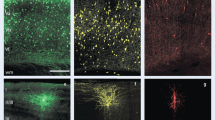Abstract
The present experiments examined the central systems which mediate the electrocorticographic activation induced by electrical stimulation of forebrain and midbrain areas known to play a role in cerebral activation. In urethane-anesthetized rats, 100-Hz electrical stimulation of the amygdaloid cmplex or dorsal raphe changed neocortical electrocorticographic activity from large irregular slow activity (LISA; 1–6 Hz, up to 2 mV) to low voltage fast activity (LVFA; less than 0.5 mV, including frequencies above 10 Hz). The LVFA during amygdala stimulation, but not that during dorsal raphe stimulation, was completely abolished and replaced by LISA after administration of the anti-muscarinic agent scopolamine (5 mg/kg, i.p.), confirming previous work suggesting that neocortical LVFA is maintained by two distinct neurochemical inputs to the cortex that can be dissociated using anti-muscarinic drugs. Electrical stimulation of the locus coeruleus area or of the superior colliculus also suppressed LISA and induced LVFA. The LVFA during stimulation of the locus coeruleus area was abolished by the anti-muscarinic drug atropine (50 mg/kg, i.p.), whereas the LVFA during superior colliculus stimulation was atropine-resistant but could be abolished by the serotonergic antagonists methiothepin (5 mg/kg, i.p.) or ketanserin (5 mg/kg, i.p.). Stimulation of 44% of electrode sites in the orbitofrontal cortex produced neocortical LVFA which was reduced by atropine and completely abolished by additional administration of methiothepin. Stimulation of the entorhinal or cingulate cortex was ineffective in producing LVFA and often resulted in the appearance of epileptiform activity. Single-pulse electrical stimulation of those sites that effectively induced atropine-sensitive LVFA (amygdala, locus coeruleus area) produced excitation of over 65% of those extracellularly recorded basal forebrain neurons that fired at higher rates during the presence of neocortical LVFA relative to LISA. About 80% of basal forebrain cells that were more active during LISA relative to LVFA were inhibited by single-pulse stimulation of the amygdala or locus coeruleus area. The present results suggest that widely distributed neuronal systems can produce electrocorticographic activation by acting through mechanisms sensitive to anti-muscarinic or anti-serotonergic drugs, suggeting that these activating influences involve the release of acetylcholine and/or serotonin. Those neural systems that produce atropine-sensitive (i.e., putative cholinergic) LVFA, believed to be dependent on the cholinergic innervation of the cortex arising in the basal forebrain, may produce electrocorticographic activation by exciting basal forebrain cells that appear to contribute to neocortical LVFA, while concurrently inhibiting cells that may contribute to LISA.
Similar content being viewed by others
Author information
Authors and Affiliations
Additional information
Received: 28 May 1996 / Accepted: 17 January 1997
Rights and permissions
About this article
Cite this article
Dringenberg, H., Vanderwolf, C. Neocortical activation: modulation by multiple pathways acting on central cholinergic and serotonergic systems. Exp Brain Res 116, 160–174 (1997). https://doi.org/10.1007/PL00005736
Issue Date:
DOI: https://doi.org/10.1007/PL00005736




